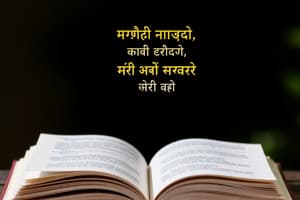Podcast
Questions and Answers
During which period does Hindi literature trace back its roots to the Vedic period?
During which period does Hindi literature trace back its roots to the Vedic period?
- Medieval Period
- Modern Period
- Sanskrit Period (correct)
- Colonial Period
Which of the following is NOT a notable poet from the modern period of Hindi literature?
Which of the following is NOT a notable poet from the modern period of Hindi literature?
- Tulsidas
- Valmiki (correct)
- Kabir
- Surdas
Which genre emerged during the modern period of Hindi literature?
Which genre emerged during the modern period of Hindi literature?
- Prose (correct)
- Renaissance Literature
- Epic Poetry
- Satirical Comedy
What is one of the official languages of both India and Pakistan?
What is one of the official languages of both India and Pakistan?
Which religious text belongs to the Sanskrit period of Hindi literature?
Which religious text belongs to the Sanskrit period of Hindi literature?
How many people worldwide speak Hindi?
How many people worldwide speak Hindi?
What is the typical word order in Hindi?
What is the typical word order in Hindi?
Which of the following is an epic retelling of the Ramayana written in the Avadhi dialect?
Which of the following is an epic retelling of the Ramayana written in the Avadhi dialect?
Which of the following is a collection of short stories set in a fictional Indian town?
Which of the following is a collection of short stories set in a fictional Indian town?
What is a unique feature of Hindi in terms of prepositions and postpositions?
What is a unique feature of Hindi in terms of prepositions and postpositions?
Which aspect makes Hindi grammar more straightforward compared to some other Indian languages?
Which aspect makes Hindi grammar more straightforward compared to some other Indian languages?
How do Hindi adjectives behave in relation to the nouns they modify?
How do Hindi adjectives behave in relation to the nouns they modify?
Flashcards are hidden until you start studying
Study Notes
Hindi: A Vibrant Language with Rich Literature and Grammar
Hindi is a rich and diverse language spoken by over 530 million people worldwide. It's the national language of India and one of the official languages of India and Pakistan. As a language, Hindi combines elements of literature and grammar that evolve and enrich its cultural heritage.
Hindi Literature
Hindi literature spans thousands of years, with its roots tracing back to the Vedic period (ca. 1500 BCE). Hindi literature has a unique and diverse range, encompassing various genres, styles, and forms. Here are some of the notable periods and genres of Hindi literature:
-
Sanskrit Period (Pre-10th Century) - Hindi's roots lie in Sanskrit literature, with the earliest works being religious texts, such as the Vedas, the Upanishads, and the Mahābhārata.
-
Medieval Period (10th-18th Centuries) - Hindi literature flourished during this period, with the composition of religious texts like the Rāmāyaṇa, Mahābhārata, and the Bhāgavata Purana in regional languages.
-
Modern Period (18th-20th Centuries) - This era marked the beginning of modern Hindi literature, with the emergence of various genres, such as poetry, drama, and prose. Notable poets from this period include Surdas, Tulsidas, and Kabir.
-
Contemporary Literature (21st Century) - Hindi literature continues to evolve, with contemporary writers exploring new themes and genres, such as the works of Manjula Padmanabhan, Rafee Ahmed Kidwai, and Mahmood Farooqui.
Some of the most famous works of Hindi literature include the following:
- Ramcharitmanas by Tulsidas - An epic retelling of the Ramayana written in the Avadhi dialect.
- Malgudi Days by R. K. Narayan - A collection of short stories set in a fictional Indian town.
- Bhamaha's Kavyalankara - One of the earliest works on Hindi poetics.
Hindi Grammar
Hindi grammar is based on the Devanagari script and draws heavily from Sanskrit grammar. Hindi grammar is often considered more straightforward than other Indian languages due to its regular verbal conjugation, case endings, and word order. However, like any language, Hindi has its unique grammatical features and challenges.
- Word Order - Hindi follows a Subject-Object-Verb (SOV) word order, which is typical for many Indian languages.
- Verbs - Hindi verbs are conjugated according to tense, person, and number, and they have distinct endings.
- Nouns - Hindi nouns have case endings that indicate their function in a sentence.
- Adjectives - Hindi adjectives can follow or precede the noun they modify, and they agree with the noun in gender and number.
- Postpositions - Hindi uses postpositions (called "post-verbs" in some grammars) instead of prepositions, which is a unique feature of the language.
Hindi grammar has many resources available, including textbooks, digital tools, and online tutorials, making it accessible to learners of all levels.
In conclusion, Hindi is a vibrant language with a rich history and diverse literature. The study of Hindi literature and grammar provides insights into its many facets and opens up a world of fascinating cultural heritage. Whether you're a student, a language enthusiast, or simply someone curious about the world, Hindi is a language that offers a rewarding and enriching experience.
Studying That Suits You
Use AI to generate personalized quizzes and flashcards to suit your learning preferences.




